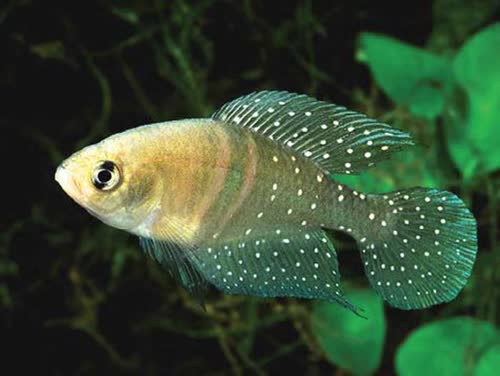|

Volume 21, Issue 4 – 15 October 2015
Dalton Tavares Bressane Nielsen and Didier Pillet: Spectrolebias bellidoi, a new annual fish (Cyprinodontiformes: Rivulidae: Cynolebiatinae) from the upper Río Grande basin, Amazon basin, Bolivia, pp. 180-187
Abstract
Spectrolebias bellidoi n. sp. is described from a temporary pool from the upper Río Grande, Río Mamoré basin, Departamento Santa Cruz, Bolivia. The new species is distinguished from all congeners by the unique shape of the female’s anal fin, which is composed of two parts, a rounded anterior area, and a posterior portion (from the 14th-15th rays onwards), gradually decreasing in size (vs. entire anal fin with a rounded outline) and a higher number of analfin rays (30 vs. 21-28), in females. It can be additionally distinguished from all congeners, with the exception of S. reticulatus and S. pilleti, by the position of the dorsal fin, which has its origin anterior to the origin of the anal fin in males.
Full description at http://www.aqua-aquapress.com/product/21-4_-2/
|
|
Stefano Valdesalici and Wolfgang Eberl: Aphyosemion bitteri (Cyprinodontiformes: Nothobranchiidae), a new killifish species from the northern Massif du Chaillu, Gabon, pp. 61-68
Abstract
A new Aphyosemion species is described from Gabon, based on eight specimens collected in a small stream within the hydrographic system of the Ikoy River on the northwestern edge of the Massif du Chaillu. Aphyosemion bitteri, new species, can be distinguished from all species of the genus by its maze-like red pattern on the caudal fin. It belongs to the A. grelli species group (Valdesalici & Eberl 2014) by sharing with A. grelli and A. mengilai the yellow basal two thirds and the greyish marginal third on the unpaired fins of females, but it can be easily distinguished from these two species by differing male coloration and meristics.
A. bitteri sp. Nov.
Volume 22, Issue 2 – 18 April 2016
http://www.aqua-aquapress.com/volume-22-issue-2-18-april-2016/
|
|
Background
The Cynopoecilus melanotaenia complex is a morphologically homogeneous killifish group, endemic from an area encompassing southern Brazil and northeastern Uruguay. It presently comprises four valid species: C. melanotaenia, the type species of the genus, and C. fulgens, C. intimus, and C. nigrovittatus.
New information
Cynopoecilus feltrini, n. sp., from the lower Tubarão river basin, southern Brazil, is distinguished from all congeners of the C. melanotaenia complex by having frontal E-scales medially overlapped, branchiostegal region orangish red in males and dorsum with few dark brown spots above opercular region...
Biodiversity Data Journal 4: e6888 (04 Apr 2016)
doi: 10.3897/BDJ.4.e6888
http://bdj.pensoft.net/articles.php?id=6888
|
|
|
|
Rivulus (Anablepsoides) hoetmeri
Abstract
Anablepsoides hoetmeri, new species, is described from middle rio Acre, a tributary of the rio Purus, Amazon drainage, Brazil. It is the first species of Anablepsoides described from that basin and the second species belonging to the Anablepsoides limoncochae species group described from Brazil. The remaining species belonging to the A. limoncochae group are mainly found in Peru, but also occur in Colombia and Ecuador. Anablepsoides hoetmeri n. sp. differs other members of the A. limoncochae group by having two longitudinal rows of 18-20 minute contact organs per row on the sides of the body, and by the coloration patterns of both males and females.
R. hoetmeri sp. nov.
Volume 22, Issue 2 – 18 April 2016
http://www.aqua-aquapress.com/?s=hoetmeri&lang=en
|
Rivulus (Melanorivulus) polychromus
Abstract
A new species of Melanorivulus is described from the middle rio Paraná basin, São Paulo state, Brazil. Melanorivulus polychromus, new species, is found in a tributary of the left bank of the rio Paraná basin, the rio São José dos Dourados. It differs from all congeners by the combination of a metallic green to light green ground colour in males, with 6-8 oblique red bars forming chevronlike rows, the chevron tips along the midline of the body pointing toward the head, and irregular narrow red lines and incomplete red bars along the lower half of the body. Melanorivulus apiamici, also endemic from the middle rio Paraná basin, is redescribed.
R. polychromous sp. nov.
Volume 22, Issue 2 – 18 April 2016
http://www.aqua-aquapress.com/product/22-2_melanorivulus-polychromus/
|
|
|